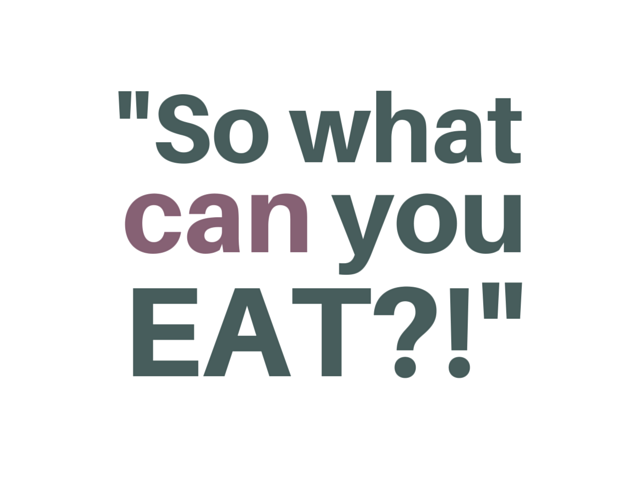
One of the questions I’m asked most frequently is “what in the world CAN you eat?!”
When I first eliminated gluten, dairy, and soy, people wondered if I had enough food options remaining. I had plenty!
Nowadays, as I work on healing longstanding gut-health issues with a strict diet, people express concern over what is left for me to eat. Still plenty! When you have as many restrictions as I do, you have to focus on what you CAN eat versus what you CAN’T.
What’s safe and what’s not
As of today, here’s my safe, unsafe, and up-for-debate list of foods. Most of the time I’m happy to be dedicated to following this list, as I’m starting to have good days again! Once in a while I feel frustrated and discouraged. The emotional, mental, and physical strain of chronic illness sets in, and I long for eggs and mango, two of my favorite foods.
Nevertheless, I realize how incredibly fortunate I am to have access to safe and bountiful amounts of food. I’m so grateful for what I can and do have.

- gluten
- dairy (including ghee)
- soy
- refined cooking oils
- refined sweeteners (though I have been sneaky and had cane sugar in some otherwise allowed treats)
- grains (even gluten-free ones — and no rice, corn, or oats in particular)
- legumes (beans, lentils, peanuts)
- starchy tubers (white potatoes, sweet potatoes, taro, cassava/yuca, etc.)
- apples, stone fruit (avocado, apricot, cherries, mango, plums, peaches, etc.), watermelon
- mushrooms
- brassica family vegetables, like cruciferous veggies and cabbages (I know I can’t handle kale, cauliflower, broccoli, or brussels sprouts)
- coconut (flour, oil, milk, sugar)
- eggs (both the whites and the yolks)
- bayleaf, cloves, cumin, dill, horseradish, oregano
- clams, oysters

Fruit
- bananas, berries, citrus
- dates, figs, and prunes (although high-FODMAP (see below), these seem to be just fine for me in small quantities once in a while)
Vegetables
- spinach and greens not in the brassica family
- zucchini and summer squash
- winter squash, especially butternut, spaghetti, and acorn squash
- carrots
- bell peppers
- tomatoes
- peas and green beans (though considered legumes, these work well for me)
- onion, garlic, shallots (thankfully these are the one group of high-FODMAP foods that I’m able to eat with no problem)
Meat
We choose meat from animals that weren’t raised with hormones or antibiotics. When possible, we select grass-fed, pastured, and/or local sources.
- chicken
- turkey
- pork
- beef
- bison
- lamb
Seafood
While I eat salmon once a week, I rarely eat other types of seafood. I’m sure there’s more I could eat.
- wild-caught Alaskan salmon
- shrimp
- tuna (I buy a brand of skipjack tuna which is said to have less mercury)
Nuts and seeds
I seem to be fine with all nuts and seeds except peanuts and perhaps cashews. Almonds and hazelnuts are both considered high-FODMAP but I am fine with both in moderate amounts. I especially like chia seeds, flax seeds, and sunflower seed butter (i.e., sunbutter).
Fats
- Extra virgin olive oil (EVOO)
- Lard (we use leaf lard from pastured pigs from a local farm)
- Tallow (similar to lard but it comes from cows — our source is also pastured and local)
Sweeteners
- honey (usually raw and often local)
- maple syrup and maple sugar
- stevia (I use a few drops of liquid stevia from time to time)

Quinoa
Though it’s a seed and not a grain, it can behave like a grain. I removed it last summer and recently reintroduced 1/4 cup with no problems. I’m waiting until early summer to try again — if it goes well, I’ll see if I can have a small amount of quinoa once a week.
Plantains
Plantains offer a wonderful source of resistant starch, but starch and I haven’t been on the best of terms the past couple of years. While tubers are still on the “cannot tolerate” list, plantains seem to be fine if I eat small amounts from time to time. I’ve had them once a month for the last three months and I’m hoping this trend can continue.
Cashews
I don’t eat cashews often, but when I have over the last few months, I’ve never had a problem. Until last time. I soaked cashews for a few hours before blending them into a wonderful “cheese” sauce for a paleo lasagna — my first lasagna in I can’t tell you how long. And it was heavenly. But within an hour or two I didn’t feel so great. I thought every ingredient in the dish was safe, so I shrugged it off. When I had leftovers the next day, the same thing happened again. Puzzled, I revisited lists of high-FODMAP foods, and wouldn’t you know, cashews were listed.
I’m not sure why they bothered me this last time, but I’m going to wait a while before reintroducing them. I’m disappointed — I really loved that lasagna.
Cane sugar
While I have limited cane sugar, I haven’t eliminated it altogether. From time to time I indulge in Enjoy Life’s dark chocolate chips or Justin’s nut butters (especially the hazelnut).
Alcohol
I enjoy an occasional glass of wine, though I did avoid alcohol last summer during my GAPS diet experiment. I’ve only had a few glasses while tackling my health issues, and if I need to avoid it again in the future, I’ll do so.
So how did I arrive at the lists above?!
Gluten, dairy, and soy free
It wasn’t until I was 27 that I was told to try removing gluten, dairy, and soy from my diet. When I did, bloating subsided, I lost weight, and I had more energy. If people asked how I could possibly give up pizza, ice cream, pastries, and other familiar foods, I think feeling and looking healthier just about covers it!
But let’s be honest. It hasn’t always been easy. In fact, I wasn’t 100% gluten, dairy, and soy free for a long time. Until 2012, I lived by an 80/20 rule, where I mostly avoided them. From time to time, I’d have a bite or two of something “special”. Sometimes I felt badly immediately afterward or a few hours later. Sometimes I didn’t feel poorly at all. And because I didn’t always feel the consequences, I was willing to gamble every once in a while for a bite of pizza, baked good, or a family member’s tempting restaurant meal.
In the fall of 2012 I started feeling sick fairly often, so I probably went by a 90/10 rule. Smart, I know.
Finally, at the beginning of 2014 I decided to eliminate gluten and dairy 100%. It was challenging at first not to even have one *tiny* bite or *super small* sip of something “special”. Over time, I found it was much easier both for me and those around me if I was 100% committed.
I know there’s been a lot of debate about whether or not non-celiac gluten sensitivity is real. Whether science supports it or not (and every month it seems like new evidence supports or refutes it), I know that I’m one of countless people who can’t eat gluten without feeling sick. Perhaps there’s an underlying issue and it’s not really all gluten’s fault. But for now, and most likely for the rest of my life, I’m not eating gluten. It’s just not worth it to me.
GAPS and Paleo-ish
Perhaps it was due to living by the 80/20 rule above, or perhaps it was inevitable, but in 2013 and 2014, I found that the list of foods I could no longer tolerate was slowly starting to grow. For a year, I removed all nuts and seeds. Oh man, did I miss nut butters.
As I became more and more sick, I looked to online resources for ideas. In a short period of time, I read numerous examples of people like me who suffered persistent GI problems but didn’t know what to blame. These folks decided to go beyond gluten free and go grain free, and they all felt much better for it.
The more I read, the more I realized that I probably suffered from leaky gut, meaning that the lining of my small intestines had been compromised. In short, my small intestines was allowing food molecules to pass through its lining and into my bloodstream, which triggered my body’s self-defense systems to fight the invaders of my bloodstream. My body began interpreting these foods as threats, which directly contributed to my growing intolerance to various foods. In order to get these food sensitivities under control, I’d first need to repair the small intestines and GI tract.
So in the summer of 2014, I abandoned my gluten free + dairy free + mostly vegetarian way of eating to start the GAPS diet (which includes a lot of meat). Since ending the 2.5 month-long GAPS experiment, my diet can best be described as paleo-ish. I don’t eat grains (even gluten-free ones), legumes (beans, lentils, peanuts), refined sugar, processed foods or refined plant oils (e.g., canola, safflower, soybean, etc.). Alcohol isn’t considered to be paleo, but I have had the occasional glass of red or white wine. Some differ on whether or not green beans and peas should be considered legumes or not for the purposes of paleo. I tolerate them just fine, so they stay! I’m happy to be paleo-ish.
Allergy testing
In the fall of 2014, I started working with an integrative medicine doctor, and one of our first orders of business was to run a food allergy test using blood samples (we used the IgG Food Antibody Assessment from Genova Diagnostics). When the results returned, I found some not-so-surprising culprits, along with two foods that I was shocked to see.
Based on my results, I needed to say goodbye to:
- wheat, corn, oats, rice, yeast
- clams, oysters (didn’t eat them anyway)
- watermelon
- mushrooms
- coconut
- egg whites and egg yolks
- bayleaf, cloves, cumin, dill, horseradish, oregano
While many might think that giving up gluten or dairy would be the hardest food challenge I’ve ever taken on, it was eliminating eggs and coconut that hit me the hardest. I’d never had problems with them before (that I was aware of), and they had become a daily staple while I explored a paleo approach to eating and healing. My doctors encouraged me to remove them for 30 days and then reintroduce them with a particular schedule. Unfortunately, the reintroduction trials were unsuccessful, and I’m waiting six months until I try again.
FODMAPs
One year ago, I had no idea what a FODMAP was. In the last few months, the notion of a low-FODMAP diet has appeared numerous times in mainstream media.
I stumbled upon the concept of FODMAPs before my first appointment with the integrative medicine team. I had been pronouncing it “food-maps” in my head until my new registered dietitian (RD) said “fod” (rhymes with “nod”) “maps”. Oh yeah.
FODMAP stands for Fermentable Oligo-, Di-, Mono-saccharides And Polyols. What?!
FODMAPS are types of carbohydrates that are not digested and absorbed well. These carbs feed bacteria in our body, which then produce gas. These carbs can also contribute to pain, bloating, and motility issues (meaning things move too quickly or not at all).
I already knew that certain FODMAP-containing foods caused problems before knowing they fell under the term FODMAP. When the RD asked me to experiment with removing FODMAPs from my diet, I happily did so.
Guess what — there are SO many fruits and veggies that are high-FODMAP foods. When I went paleo, I never thought I’d need to cut back on the types of vegetables I ate. Many paleo food bloggers share gorgeous recipes with high-FODMAP foods, but I’ve learned that just because a “cheese” sauce with cauliflower or cashews sounds like a great idea, it doesn’t necessarily feel like a great idea. Trust me.
Here’s a great list of high-FODMAP foods, and if you’re wondering what’s left, here’s a list of low-FODMAP foods. Thankfully I tolerate a few high-FODMAP foods quite well and keep them in my diet.
If you’re new to FODMAPs, I think these reads from Standford Health Care, Dr. Jockers and The Paleo Mom are helpful. Dr. Sarah of The Paleo Mom includes a list of foods that are paleo friendly AND low-FODMAP. I consulted the list often when I first made the transition to paleo PLUS low-FODMAP.
Bottom line: JERF
No matter where my wellness journey takes me, my food philosophy moving forward is to “just eat real food” or “JERF”, as Sean Croxton encourages his readers and listeners. I feel better in the short term eating real, whole foods, and I’m betting they’ll help me feel better in the long run too.
Excellent write up Heather! JERF!
Sean sells a shirt that sells JERF I think…I definitely need to get something that sells JERF on it. Maybe a reusable shopping bag?!